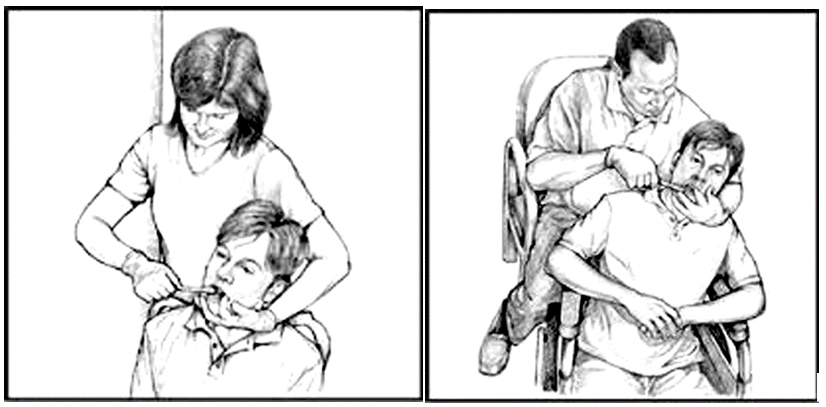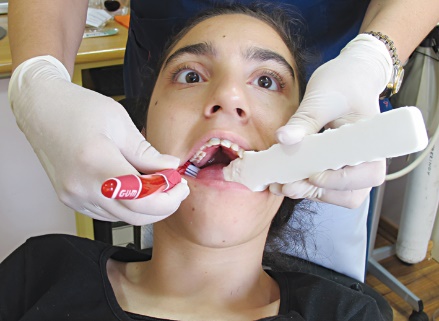Mental/Developmental Retardation
Source of information: “Dentistry guide for parents and carers of children with disabilities and health problems” of the Pediatric Dental Association of Cyprus
Mental/Developmental Retardation
Oral characteristics
High chances of Gingivitis and Periodontitis
THE CHANCES OF DENTAL CAVITIES ARE AT THE SAME LEVELS WITH THE GENERAL POPULATION
Most orthodontic abnormalities, missing teeth, delayed tooth eruption, and hypoplastic teeth are observed.
There are many bad oral habits such as bruxism, teeth grinding, mouth breathing, tongue thrusting during swallowing, self-injuries such as lip biting, tongue biting etc.
There is a high chance of trauma to the teeth.
Tongue thrusting while swallowing

Cooping mechanism at the Dental clinic
- Treatment is often manageable in the Dental clinic especially if the first visit to the Dentist is done very early for PREVENTION.
- Inform the Dentist about the level of perception the child has.
- Morning appointments where the child is rested help the child co-operate better.
- Clean and short commands that are repeated
- Use the say-show-do method to familiarize the child with the Dentist.
- Developing trust between patient and Doctor. It is better to use the same room each time and the same staff in order for the environment to be familiar for the child.
- Reward good behavior both verbally and with a gift.
- Where the child’s perception allows it, various songs, music, narration of a story are used to draw the child’s attention from dental work while helping to increase his co-operation.
- If the medical history of the child allows it, the Nitrous Oxide mask can be used which helps the majority of children relax and is a great help in making the dental treatment possible. Also, Nitrous Oxide aids in reducing the gagging reflex, making Dental treatment miraculously possible where it would be considered impossible!
- Special protective sleeves are used for security purposes where needed.
- A Dental mouth dispenser, tongue presser, rubber isolator and surgical aspiration is used so that treatment can be safely performed and tolerable by the patient.
- General anaesthesia as a last option
- Some techniques are the same as those used in children with autistic characteristics (see Chapter Autism).
Nitrous Oxide Mask

Care at home
Appropriate position when brushing the teeth
If the child is on a wheelchair, stand or sit behind him and on the side. Control with your hand his head by holding him under his chin with light support on your body. Many times two people are needed to be able to brush the teeth of the child. One will hold the child’s hands and the other will brush the teeth.

Best method to open the mouth
There are ways that you can open the child’s mouth and protect your hands from possible biting and the child itself.
Toothbrushes that are provided in the market

Mouth dispensers that are fabricated with a soft material for home use, which can better help in a safe opening of the mouth.

Use of Dental floss
In order to be able to clean the areas that the toothbrush cannot reach, you must use dental floss. There is a difficulty in the use of floss and it takes a lot of practice, but it will be very beneficial if it can be used. In cases where you cannot use traditional floss for your own protection (avoiding being bitten), there are a number of other products available in the market that can help you.

This requires teamwork and participation from the whole family. Many times one person is unable to do so. Usually one needs to hold or care for the child and another to provide oral hygiene procedures. The main element required is the will and strength of the caregiver.